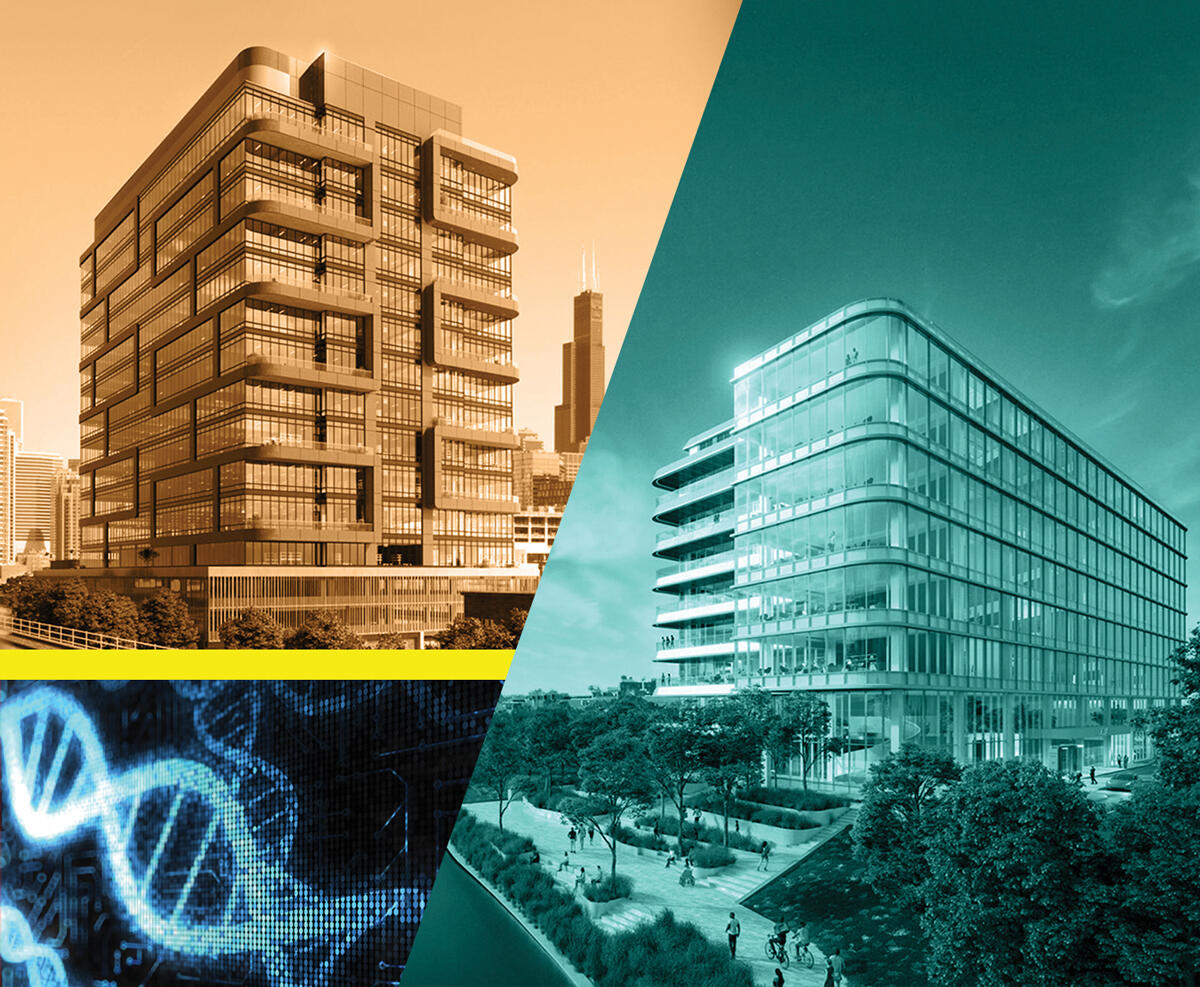
Chicago’s 400 North Aberdeen (left) and 1229 West Concord
Chicago’s ambition to become a center for life sciences got a boost from a surprising tenant: Google.
The tech firm wants to lease 200,000 square feet in Trammell Crow’s new 400,000-square-foot Fulton Market building at 400 North Aberdeen Street, which is geared toward laboratory use, bolstering hopes for developers eager to fulfill the city’s plans to create a life science hotspot that could eventually rival Boston and San Diego.
Yet some brokers and developers suspect Google will use the building as a traditional office instead of for Verily, a sibling life science firm. If that’s the case — and it’s still a big if, because Google hasn’t revealed its plans — it would undercut the city’s long-term goals and show that Chicago needs a faster office rebound as it embarks on its ambitious life sciences aims.
“This Google lease may be for some life science component, and I’m hoping that’s the case,’’ said Mark Goodman, whose namesake Chicago development firm just bought a $15.8 million site on Elizabeth Street to build a 16-story lab-oriented building. “If it is, this would be extremely significant. If it’s not, I have to put my blinders on, stay focused on what we’re trying to do and generate interest from potential life sciences companies.”
The conundrum is a microcosm of the long path ahead as Chicago seeks to compete with a herd of developers who galloped into such established markets as Boston, San Diego and Silicon Valley. Lab rental rates in Boston exceed $100 per square foot, more than twice Chicago’s average rate.
Chicago’s academic institutions graduate talent in life sciences and other research disciplines, and the city hopes to keep more of them local as they advance in their careers. Companies that started in university labs grew by moving to one of the coasts, with few lab options available in Chicago. Developers see an opportunity to change that.
For now, Google’s plans in Chicago are a mystery in the real estate community. Google didn’t respond to requests for comment. Its big real estate investment plans excited commercial landlords, but Goodman isn’t sure an office lease would be a good sign for Chicago’s life sciences goals.
“That’s a negative,” he said.
An office lease to the tech firm would be another indication of the lengths Chicago’s lab landlords are willing to go to land a big tenant or two in the pricey life sciences sector.
Life science ambitions
Google’s possible encroachment into a building designed for lab users wouldn’t be the first pivot a promising lease caused Trammell to make.
The developer bolstered its position as a lab landlord after originally pitching 1375 West Fulton Street as an office. It’s down the road from the separate Trammell building Google is considering. When Trammell had a chance to land Xeris Pharmaceuticals in the 14-story project, it switched to a lab-oriented design, signing the firm to an 11,000-square-foot lease. Two other lab users then inked their own leases.

“My initial reaction to Google’s potential lease was a little bit of disappointment,” said Michael Marrion, a Cresa broker in Chicago. “I would have much rather seen three big up-and-coming life sciences tenants take that space. But if you’re Trammell, you can’t turn down Google. It’d be foolish.”
Trammell Crow said its executives weren’t available to comment.
Tishman Speyer’s Fulton Market development at 320 North Sangamon followed a similar office-to-lab planning process after Hazel Technologies said it would move in.
Sterling Bay also stepped further into lab development once it had a taste. After gaining a life sciences tenant at 2430 North Halsted Street, the company made its first building — at 1229 West Concord Place, in the Lincoln Yards site — an eight-story, 280,000-square-foot life sciences workplace. Construction just topped off. No tenants have been announced, though Sterling’s building could allow existing life sciences tenants at Halsted to expand locally.
Chicago is on track to nearly double its commercial lab space, with more than 864,000 square feet under development. As of the fourth quarter last year, none of it was pre-leased, CBRE found.
Read more



Short supply
Supply is still short, with just under 300,000 square feet of vacancy in the fourth quarter, representing 19 percent of the city’s total lab stock, while 22 tenants were in the market for 350,000 square feet of demand.
Chicago is facing nationwide competition. A record 31 million square feet of lab space was under development in the top 12 markets during the fourth quarter, according to CBRE.
“The amount of proposed products is significant,” said Paul Giannopulos, a Chicago-based JLL broker who counts Abbott Laboratories among his clients. “I’ve been in the life science game since 2005. We didn’t work in our backyard very often because we just didn’t have the space for those users. Now we’re able to help these growing companies in Chicago.”
Even bulls know Chicago won’t match Boston or San Diego anytime soon.
“I’m specializing in life sciences, but it’s emerging here,” said David Burden, a Chicago-based Colliers broker. “It’s not quite enough to dedicate the entire practice to. There’s not that much business, but it’s growing. I see an opportunity to grow with it.”
In Boston, almost half of the 11 million square feet of labs due for completion by 2023 is already leased, CBRE found. With lab rents in Chicago about $50 per square foot, the city has potential to land companies that can’t secure space in tight coastal markets and want a bargain as they expand.
“We’re all growing, so it may be a race to see who can have that product available when these other markets can’t,” said JLL’s Dimitri Tsiribas.
For Goodman, the outcome of Google’s negotiations with Trammell will inform the market.
“It’s the most difficult, challenging product to develop,” Goodman said. “Life sciences companies start and get venture capital and want to be in business four months later, which means you have to build these buildings on spec.”
Lab users co-locating with tech firms and tenants in other sectors is expected and welcomed, Sterling Bay’s Suzet McKinney said, while brushing off notions of Google limiting the city’s lab supply during industry efforts to expand it.
“I think we’re going to see more of this convergence and multi-tenancy, as well, as demand picks up in the market and it matures,” Giannopulos said.
If Google inks a lease on Aberdeen, it highlights the growing appetite for real estate with tech-infused frameworks and amenities. Developers want to be able to market buildings to both lab and office users, Tsiribas said.
“Electrochromic windows so they don’t have blinds but you can use your smartphone to change the dimness — all tenants like that,” Giannopulos said of Trammell’s new building. “The HVAC has 12 air changes per hour — all tenants are looking at that now with Covid. When you look at a traditional new lab building, it could be very advantageous for most office-type users.”
